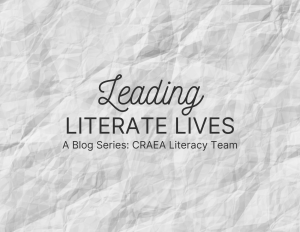Leading Literate Lives-Part 2: What Can Assessments Do for Us?
 “If you know what each assessment is designed to do and what it does (and does not) tell you, your instructional decisions can be better informed.” -Dr. Louisa Moats and Dr. Carol Tolman
“If you know what each assessment is designed to do and what it does (and does not) tell you, your instructional decisions can be better informed.” -Dr. Louisa Moats and Dr. Carol Tolman
When we think about comprehensive literacy systems, including those aligned with the Science of Reading, assessment is an integral piece. As the quote above from Moats and Tolman illustrates, a deep understanding of assessments allows us to make intentional instructional decisions, which gets at the heart of assessing students – we want to impact teaching and learning.
In order to use assessments in an efficient and effective manner, it is critical to understand the four types of assessment, their purposes, and how data from each can be used to support literacy instruction. The four types of assessment include summative or outcome assessments, screening measures, progress-monitoring tests, and diagnostic surveys (Moats & Tolman, 2019). Each type of assessment is defined below:
Summative Assessments: Summative or outcome assessments are administered at the end of the year for accountability purposes. These types of assessments are typically norm-referenced, meaning they compare students to each other and are considered high-stakes. In literacy, reading comprehension is often the sole focus of these assessments.
Screening Measures: Screening measures are administered at least three times a year and are utilized to identify at-risk students. These assessments are efficient in that they should take approximately 10-15 minutes for a student to complete and, more often, measure word recognition over language comprehension skills.
Progress-Monitoring Tests (Formative): Once students have been flagged as at-risk by a screening measure and are provided an intervention, progress-monitoring tests are then used to measure progress toward a goal. Progress monitoring tests are formative, in that they support teachers in making instructional decisions, and should be given frequently (every 1-3 weeks) to monitor student progress. If progress monitoring data show limited or slow progress, it is important to first check the fidelity of implementation and then change the intervention, if needed.
Diagnostic Surveys: Diagnostic surveys are administered to students identified as at-risk, and are utilized to dig deeper into a particular student’s knowledge and skills. Teachers use diagnostic surveys to get a more detailed picture of what a student knows and is able to do, and in turn should inform instructional decisions.
Asking the Right Questions
“Before any problem can be solved, the right questions need to be asked.”
-Dr. Louisa Moats and Dr. Carol Tolman
Now that we have a shared understanding of the types and purposes of assessments, we want to consider questions that help us think about what we already know about students, and if additional information is needed to make educated decisions about instruction. In their work, Moats and Tolman highlight a series of questions for literacy teachers to consider. They first honor what we know about our students, as oftentimes we already have the data we need to make instructional decisions. If we decide to dig a little deeper, this series of questions is designed to pinpoint specific areas of literacy needs:
- What do I already know about the student?
- Does the student need additional instruction to bolster phonological skills?
- Does the student have a significant problem with accuracy and/or speed of word recognition?
- Which phonics and word-recognition skills should be emphasized in instruction?
- Does the student need intervention in spelling and writing?
- Does the student appear to have significant problems comprehending language in general?
Notice how the questions focus first on the word recognition strand of Scarborough’s “Reading Rope” (described in more detail in the first post in this series). These word recognition skills, including phonological awareness, decoding, and sight recognition, are considered constrained skills. Once they are acquired, we have them for life. We ask questions about these skills first because once these are automatic for students, their cognitive space is cleared for other aspects of the reading process. Question five asks us to think about spelling and/or writing, and the final question asks teachers to consider the other strand of Scarborough’s Reading Rope – language comprehension.
Next Steps
When thinking through these questions, we might realize we don’t yet have the necessary assessment tools to get at the answers. Taking an inventory of the types of assessments your school or district currently uses, and thinking about what additional assessments are needed to answer questions like these might be the next step in your assessment journey. For more information about how to conduct an assessment inventory or for support with this process, contact your literacy consultant.
References:
Moats, L. C., & Tolman, C. A. (2019). LETRS (3rd ed., Vol. 1). Lexia.
Connected Learning Opportunities:
What is the Science of Reading? series (LMS)
Applying the Formative Assessment Process: Overview (LMS)
Helpful Resources:
Evidence-Based Assessment in the Science of Reading
Evidence-Based Assessment in the Science of Reading – One-Page Overview
IA Dept of Ed Formative Assessment
